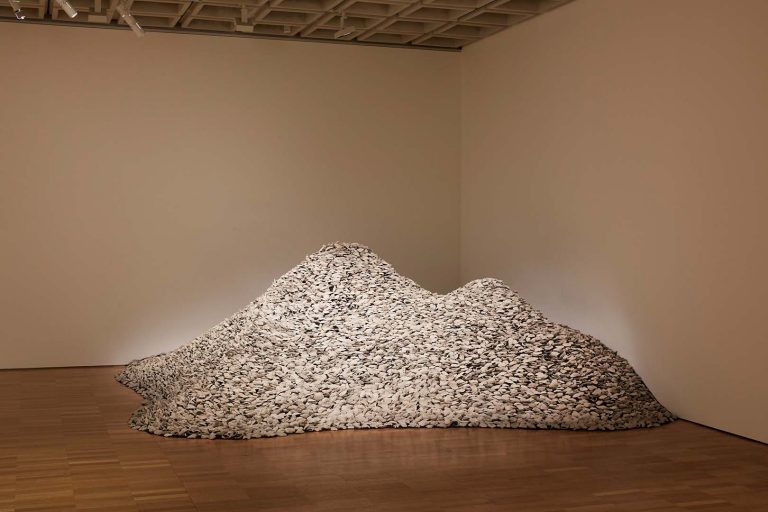We acknowledge the Traditional Owners of the land on which the Queensland Art Gallery | Gallery of Modern Art stands and recognise the creative contribution First Australians make to the art and culture of this country.

Megan Cope / Quandamooka people / Australia b.1982 / RE FORMATION (Noogoon/St Helena Island) 2019 / 12 000 pieces of cast concrete, ilmenite / Dimensions variable / Purchased 2019 with funds from the Contemporary Patrons through the Queensland Art Gallery | Gallery of Modern Art Foundation / Collection: Queensland Art Gallery | Gallery of Modern Art, Brisbane / © Megan Cope
Megan CopeRE FORMATION (Noogoon/St Helena Island) 2019
On Display: GOMA, Gallery 3.5
Megan Cope’s RE FORMATION (Noogoon/St Helena Island) 2019 takes the form of a traditional oyster shell midden. This sculpture is part of the artist’s wider research on shell middens created by Australia’s First People, which she argues should be thought of architecture rather than simply as rubbish heaps – from which the term ‘midden’ is derived.
Middens still exist on Cope’s country of Minjerribah (North Stradbroke Island), but they are mere remnants of once-towering masses. From the first arrival of Europeans until the late nineteenth century, middens around Australia were burnt for lime, which was used in the mortar of colonial buildings. This practice destroyed key markers of Aboriginal occupancy and reinforced the myth of terra nullius. By re-creating shell middens, Cope restores this symbol of Aboriginal people’s continuous inhabitance of the landscape.
In RE FORMATION (Noogoon/St Helena Island), Cope adapts dry-stone wall construction to create a young midden of hand-cast concrete shells embedded in black, sand-like copper slag. Each time this work is presented a subtitle is added referring to a local midden. Noogoon, later named St Helena Island, is situated where the Brisbane River enters Moreton Bay, and was a key site for the lime burning industry in this region.
Quandamooka artist Megan Cope lives and works on Minjerribah (North Stradbroke Island) and in Melbourne. Her practice explores the relationship between environment, geography and identity, inspired by stories of her people and country.
Cope often uses maps in her work, drawing on the study of place names to investigate methodologies of colonisation. For Cope, the ‘renaming place and replacing Aboriginal names was an assertion of colonial power and dominance’.1 She adds new layers to historical maps, inserting local Aboriginal names and places to reveal and assert Indigenous identity within the landscape. Similarly, her sculptural installations seek to recreate traditional markers, which once identified sites of significance and places of habitation, as reminders of continuous occupation of these lands by Indigenous Australians.
Endnotes:
1 Megan Cope, ‘Defying Empire: 3rd National Indigenous Art Triennial’, National Gallery of Australia, <https://nga.gov.au/defyingempire/artists.cfm?artistirn=37728>, accessed November 2019.
Discussion
1. Why is the work titled RE FORMATION?
2. Many shell middens in Australia are thousands of years old. What does this reveal about the term terra nullius and historical accounts of European settlement?
3. Cope argues that traditional shell middens should be considered architectural sites rather than refuse heaps. Discuss why the term architecture might apply to these formations.
4. An earlier work, Cope used sand from Minjerribah (North Stradbroke Island) and discarded beer cans moulded into the shape of shells. What is the significance of these materials for the artist?
Activities
1. Research traditional shell middens in Queensland. What can middens tell us about Indigenous history and culture? What threats do these formations face today? Design a poster that promotes the protection of midden sites.
2. Find small objects — either natural or synthetic — that have a pattern. These could be shells, seeds, leaves, doorknobs or decorative tiles. Draw and repeat the pattern within a form.
3. Consider what markers you use (architectural, geographical and environmental) to navigate your way for example from home to school, to visit friends or relatives, or to and from town. Choose one and create a three-dimensional representation of this feature. Display together as a class to form a landscape.